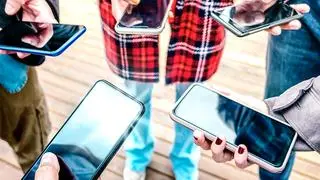Ever since the death of Apple co-founder Steve Jobs, it has seemed as if the company were stuck in a constant cycle of rumours, hype and consequent disappointment. While some of it may have been due to unreasonable expectations and an ever-hungry technology commentariat, it is difficult to deny that the last three years have seen the iPhone maker act a little more hesitant, a little unsure of itself.
There have been some questionable hiring and firing decisions, lesser ground-breaking products, and a muted silence as to what a post-Jobs Apple should look like.
On Tuesday, however, current CEO Tim Cook took the first public step in making Apple his own, wiping away the cobwebs and proving that he is indeed the holder of the keys to the company’s roadmap. The new product launches, therefore, are best seen as a mixture of the old and the new, the familiar and the unknown, and of a world inspired by and bereft of Steve Jobs.
Let’s first consider the new iPhones. In hindsight, the iPhone 4S (and maybe the iPhone 5) were probably the last products that Apple looked at from a purely ‘how should we build a better smartphone’ perspective. The iPhone 5S and the iPhone 6 have been about looking to build on top of the smartphone platform, pushing to solve a painful problem. Specifically, these two phones are about changing the antiquated way we pay for physical and online goods.
If it isn’t clear, the iPhone 6 is Apple’s way of telling us that the smartphone wars, while still important, has shifted battlefields. The specification and smartphone OS wars can still continue, but building on top of the smartphone platform—and solving specific problems, thus making the smartphone ever more useful and ubiquitous—is where the puck will be in a few years. Samsung, Lenovo, HTC and Microsoft have their work cut out for them.
Incidentally, this is a tried and tested Steve Jobs strategy, very similar to the way the iPod and iTunes paved the way for the initial iPhone, whereby Apple builds layer upon layer.
The 5.5-inch iPhone 6 Plus, on the other hand, is proof that Apple under Tim Cook is a company that is willing to succumb to market pressures when it is necessary. The demand for larger screen phones is primarily driven by Asian markets, where the penetration of Apple products has historically been the lowest.
The future of iPhone’s growth will be driven by bigger and better screens.
From a product arrangement standpoint, however, the iPhone 6 Plus complicates matters. Based on initial hands-on reviews, the 6 Plus looks like it might cannibalize the iPad Mini if the general consumer audience ends up taking to it. Consequently, the iPad Mini and the iPad will no longer be able to rest safely in the “tablet category”. This could put pressure on Apple into turning the iPad into a ‘laptop-killer’, the way Microsoft is trying to do with the Surface Pro 3.
Best watch ever?Next comes the undoubtable star of the event: the Apple Watch. A betting man might say that this new product category will determine the future of Tim Cook’s legacy; it will decide whether Apple moves from being a pure consumer technology company to one that sits firmly in the intersection of fashion and technology.
And make no mistake about it: the Apple Watch is a device that sits between ‘pocketable’ computing (current smartphones) and intimate computing, where the devices will find a place on our bodies and seamlessly interconnect with the help of a background smartphone. There is little doubt that what sets Apple Watch and Android Wear/Galaxy Gear apart is not the number of software applications, but the number of customizations and product choices that Apple offers. The Apple Watch is clearly being positioned as a watch, whereas Android Wear is clearly a wearable.
It is also immediately clear that the Watch is a first generation product—the similarities in structure and design between the Apple Watch and the first generation iPhone are quite apparent. Though Vogue Magazine is yet to take a stand, the Watch looks stunning and unrefined at the same time. Successive generations of the Apple Watch will fix this rawness, but the basic template is there.
All of Apple’s characteristic design innovations are present—the digital crown, which is the latest in the long history of user interface accomplishments by the company—as well as more quirky and humane features such as heartbeat communication (the potential for new types of social messaging is vast) and the ability to use the watch as a walkie-talkie.
For U.S users, the combination of Apple Pay and Apple Watch may prove to be a compelling ‘must-buy’ use-case. The rest of the world, however, may be a little unsure.
A deciding factor that was conspicuously missing was battery life: there’s no point in talking about the future of the Apple Watch if its charge can’t last more than half a day.
Money mattersAnd last, but certainly not least, we come to Apple Pay. The new payment system, which is the most comprehensive to come out so far, is clearly the magic sauce that ties the new device ecosystem together. (In this, Apple Pay is very much like iTunes).
The ingredients are all there: the Apple Watch (and the iPhone 6 to a lesser extent) is the vector and the large number of merchants that Apple announced are those who are willing to take a chance on eliminating the physical credit card.
Apple is clearly going where the money is, as analyst Horace Dediu has pointed out. The very fact that a payment system has received ‘Apple’ branding (unlike iTunes) speaks volumes in itself.
The company is also naturally stressing on the fact that it is adding value by adding security to the whole payment process. Indeed, security and ease of use seem to be built into this entire process. “Apple doesn’t know what you bought, where you bought it, or how much you paid for it,” Tim Cook beamingly announced, in a clear dig at Google. And he’s right—though whether security will prove to be a good enough assurance for wide-spread use is still yet to be seen.







Comments
Comments have to be in English, and in full sentences. They cannot be abusive or personal. Please abide by our community guidelines for posting your comments.
We have migrated to a new commenting platform. If you are already a registered user of TheHindu Businessline and logged in, you may continue to engage with our articles. If you do not have an account please register and login to post comments. Users can access their older comments by logging into their accounts on Vuukle.